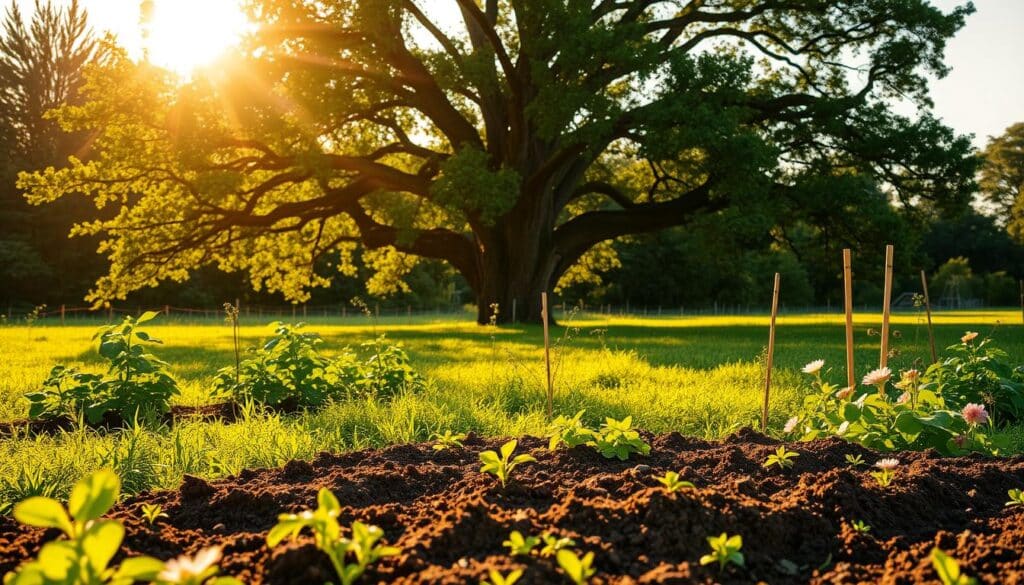Anúncios
Proper plant fertilization is key to a healthy, productive garden. Learning about fertilization techniques can boost growth, flower blooming, and fruit production. With the right nutrients, your plants will flourish all season.

Seek App
The Importance of Plant Fertilization
Fertilizing plants makes a huge difference in their health and growth. The soil needs these nutrients to help plants thrive. But sometimes, the soil loses these nutrients due to weather and growing the same crops over and over.
Anúncios
By adding fertilizers, we give the soil back these important nutrients. This helps plants grow better and produce more. Greener gardens aren’t just good for the gardener. They also help the environment by adding variety to it and supporting nearby ecosystems.

Anúncios
Understanding Essential Nutrients
Plants need the right mix of nutrients to grow well and stay healthy. Macronutrients like Nitrogen, Phosphorus, and Potassium are key because plants use a lot of them. They help plants grow, bloom, and produce fruit. When these nutrients are balanced, plants develop better.
Micronutrients, such as iron, copper, and zinc, are also vital but needed in tiny amounts. Even in small doses, they greatly impact plant health. These nutrients help with important actions like photosynthesis and enzyme function, crucial for a plant’s life.
Both macro and micronutrients are essential for plant growth. Checking soil conditions and nutrient levels is important to give plants what they need. A good fertilization plan includes both nutrient types for healthy plants and good harvests.
Identifying Nutrient Deficiencies
Knowing when plants lack essential nutrients is key to keeping them healthy. Gardeners should look out for signs like yellow leaves, which may mean not enough nitrogen. Short plants might need more phosphorus. And if leaves have browning edges, they could lack potassium.
Testing the soil regularly is a smart move. It shows which nutrients are missing. By knowing what’s lacking, gardeners can figure out how to make their plants thrive. Catching these signs early helps keep gardens looking great.
Nutrient Availability in Soils
Healthy plant growth relies on soil nutrients. Soil texture, organic matter, and pH levels are key factors. They decide how well plants can use these nutrients, aiding gardeners in refining their planting approaches.
Soil texture impacts how nutrients are held and drained. Sandy soils lose nutrients quickly because they don’t hold water well. On the other hand, clay soils grasp nutrients thanks to their tiny particles. While good for some plants, too much water can cause root problems.
Organic matter, like compost or aged manure, boosts soil health. It gives a steady supply of nutrients as it breaks down. This action creates a healthy soil environment that supports plant growth.
The pH level plays a big role in nutrient availability. Most plants do best in a pH of 5.5 to 7.0, making nutrients easier to absorb. If soil is too acidic or alkaline, plants might not get the nutrients they need, affecting their health.
Choosing the Right Fertilizer
Picking the right fertilizer means knowing what your plants need and the kinds of fertilizers out there. Organic fertilizers, like compost or manure, improve soil health and structure. They also give essential nutrients slowly over time.
These options boost good microbial activity and make the soil better overall. In comparison, inorganic fertilizers give nutrients fast. This is good for plants that grow quickly or if there’s a certain nutrient they really need.
But, using too much of these can harm the environment. It can mess up the soil and pollute the water.
When deciding between organic and inorganic fertilizers, think about the following:
- Soil health and condition
- Plant nutrient requirements
- Cost and availability
- Environmental impact
Testing your soil helps you choose the right fertilizer for your garden’s specific needs. Knowing the good and bad about organic and inorganic fertilizers lets you pick wisely. This way, you help your plants and the environment.
Applying Fertilizer Effectively
Applying fertilizer right is key for healthy plants. Knowing when, how much, and how makes a big difference. Always start by following the instructions on the package. This ensures your plants get exactly what they need.
It’s important to spread fertilizer evenly. This avoids harm to your plants and makes sure all the soil gets nutrients. Always check the soil’s moisture before applying. Dry soil can cause nutrients to wash away, which wastes your effort. The right moisture means your plants take in more food.
Using these methods will make your garden thrive. Keep checking and tweaking how you fertilize. This ensures your plants get the best care for their growth.
Timing Your Fertilization
Timing fertilization right is key to feed plants well for their health. Early spring is the best time to start, as it fits with when most plants begin to grow. When it gets warmer, plants are better at taking in the nutrients they need to grow.
Creating a good fertilizing plan makes the process more effective. Keeping an eye on how the plants are doing helps figure out what they need. Each plant might need a different schedule, depending on its stage and the environment around it.
- Monitor soil moisture levels to avoid nutrient leaching.
- Consider the specific growth cycles of individual plants.
- Adjust feeding schedules based on weather conditions and plant responses.
Keeping a regular check and adjusting how you fertilize helps plants stay healthy. This way, you get the most out of the nutrients you give them.
Plant Fertilization: Frequency and Application Methods
Understanding how often to fertilize plants and how to do it right boosts their growth. Slow-release granular fertilizers are great for deep-rooted plants. They provide a steady flow of nutrients over time. This helps perennials and big plants get the constant nutrition they need.
Water-soluble fertilizers give nutrients fast, perfect for plants that need help right away. They’re easy to use and great for feeding annuals or during key growth times. Choosing the right time to use each kind can greatly help your plants grow healthier and more productive.
The fertilization frequency changes based on the plant’s type, growth stage, and where it lives. Flowers, for example, may need more food when they’re blooming. Watching how plants react to different ways of fertilization can improve your garden’s overall health.
The Role of Organic Materials in Fertilization
Organic materials are key to better plant growth. They use organic fertilizers and compost. These elements boost soil health by adding more nutrients. They also make soil structure better and help it hold water.
As organic matter breaks down, it gives plants important nutrients over time. This supports plants’ health and growth for the long run.
Adding organic fertilizers to soil does two things. It gives plants crucial nutrients and increases good microbes in the soil. These microbes help plants get more nutrients. Using compost is a green way to reuse organic waste. It makes gardening and farming better for our planet.
Common Mistakes to Avoid
Gardeners often struggle with fertilizer mistakes that stop their plants from growing well. The biggest mistake is using too much fertilizer. This can burn the plants and harm the soil over time. It’s important to avoid errors based on the season to keep plants healthy.
To dodge these common errors, gardeners should:
- Conduct soil tests to understand nutrient levels and requirements.
- Adhere to recommended application rates specified on fertilizer packages.
- Be cautious not to fertilize during inappropriate seasons, as this can lead to poor nutrient absorption.
- Rotate fertilizer types based on plant growth stages to prevent nutrient buildup.
Boosting Soil Health for Better Nutrient Uptake
Improving soil health is key for better nutrient absorption by plants. Healthy soil helps plants get the vital nutrients they need. This can lead to stronger growth and health. There are several methods gardeners can use to make this happen.
Adding organic matter like compost or rotten manure feeds the soil with nutrients. It also makes the soil structure better. This boosts the activity of microbes. They break down organic materials, making nutrients available to plants.
Crop rotation is another great method. It involves changing crops to avoid using the same resources over and over. This way, gardeners can keep the soil rich and avoid nutrient loss. It helps create a varied plant world and improves the soil’s health.
- Minimize chemical usage to promote natural soil processes.
- Regularly test soil to monitor nutrient levels.
- Utilize cover crops to reduce erosion and enhance nutrient cycling.
Using these soil improvement tactics boosts nutrient uptake. This results in healthier plants and more plentiful crops. Embracing these methods is good for the garden and the planet.
Environmental Considerations
Knowing how fertilizer affects the environment is key for sustainable gardeners. Traditional fertilizers can harm soil and water through runoff. Using eco-friendly fertilizers helps solve these problems and supports healthy ecosystems.
Organic materials in sustainable gardening cut down on chemicals and improve soil health. With eco-friendly fertilizers, the good impacts reach beyond your garden. They help all kinds of life, support local animals, and keep water sources clean.
- Opt for organic compost to enrich soil without harmful chemicals.
- Select fertilizers with slow-release formulations to minimize leaching.
- Incorporate cover crops to naturally replenish nutrients and prevent erosion.
Switching to sustainable gardening helps plants and helps save our planet for future generations.
Conclusion
Throughout this article, we learned that using the right plant fertilization methods is key to a successful garden. Knowing what nutrients your plants need helps you choose the best fertilizer. This way, your plants grow healthy and strong.
Choosing the correct fertilizers and using them at the best times can make your garden flourish. Paying attention to your plants’ needs lets you fine-tune your approach. This careful attention leads to healthier plants and more produce.
To wrap it up, the fertilization techniques we talked about can really change how you garden. Knowing and applying this information will make your garden’s health and output much better.



